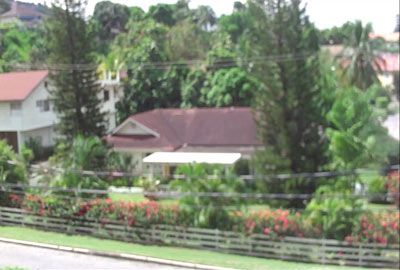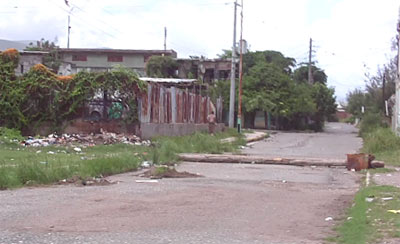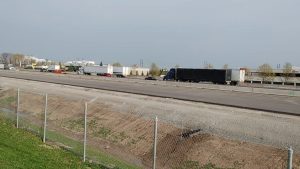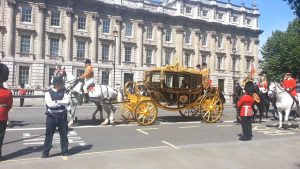
The scene is haunting. It recalls those pictures of war ravaged African cities where dark faces congregate by seemingly useless buildings to stare at nothing as feet force people on to nowhere in particular. But it is West Queen Street, downtown Kingston, Jamaica, the Wednesday when things are supposedly returning to normal after the Jamaica police-military’s bloody weekend incursion to pry American’s most wanted, Christopher ‘Dudus’ Coke, from his Tivoli Gardens stronghold, to be extradited for alleged illegal drugs and gun trading.
Six miles to the north, the electronic gates, multiple dead bolt locks and security alarms on upper St Andrew homes stand in ironic apposition to the old cars, debris and gas bottle barricades set up by supporters of Coke, to keep the security forces out of their West Kingston community, represented in parliament by Prime Minister Bruce Golding.
The official tally so far of 73 civilians killed in an effort to serve a warrant, is becoming in itself a human rights cause celebre but masks a more damning social political scene that throws up cathartic moments where the ‘have nots’ are in contention with the ‘haves’ for a pie that has not grown much since 1962 when Britain granted the island independence.
While many have described the Tivoli incursion starting Sunday May 22, 2010 as a surgical procedure to expunge organized criminals willing to challenge the sovereignty of the state, a prominent academic in the medical fraternity in a private conversation said a mental health metaphor was a more apt analogy.
“The society is made up of a small minority which needs institutional confinement for their treatment and the remainder needs intensive therapy,” he opined.
The schizophrenia to which he alludes is rampant in Jamaica where it is difficult to discern where law abiding civil society ends and criminality and corruption begins. And if those who say the Tivoli episode is a surgical operation to remove a cancerous growth are correct, the country, with its average of 1,600 murders in a normal year, is in for a round of bloodletting as the cancer has spread throughout the body politic, while Golding’s Jamaica Labour Party (JLP) administration moves to expunge it.
Since Mr Beeston’s hog crawl on the Liguanea Plain was bought out and the swamps drained to relocate the activities of the pirate capital of Port Royal from across the harbour after the devastating 1692 earthquake, Kingston has shared in the tumult and fractiousness that is Jamaica.
With its natural protected harbour bounded by the Plaisadoes peninsula, Kingston grew to become the prime shipping port and commercial centre, and in 1872, replaced Spanish Town (the old St Jago de la Vega of the original European conquerors) as the political capital.
Although there was a vestry system with a mayor and aldermen not much was done by the city’s municipal administrators and their first major stirring was during the period of the Haitian revolution of the late 18th and early 19th centuries when constabulary functions were introduced to keep at bay any similar rebel activities as may follow Haitians fleeing to Jamaica.
The seven square miles of the city and parish of Kingston, which was the business and workplace of the merchant class, has never taken on the characteristics of a big city in the way of the Spanish capitals of Santiago, San Juan and Havana, acquiring instead an air of impermanence that has lasted into contemporary times with no grand infrastructure or buildings and the town going to sleep at dusk when stores shutter up.
In the post emancipation years, the merchants who lived atop their stores in King Street, Harbour Street, Duke Street, soon moved out to residential communities in Rae Town and Breezy Castle in the East and Kingston Gardens in the north but the western sections remained primarily working class settlements.

As the growing numbers of country folk flooded the tiny city, crowding into the neighbourhoods built from former cow and hog pens, the business class migrated northerly into the foothills of the Blue Mountain range and Red Hills of neighbouring St Andrew parish, before eventually building their gleaming mansions on the hillsides overlooking the city.
The western part of Kingston and lower St Andrew which borders it on that side, were another story. Rastafari folk historian, Sydney Ricketts, who grew up in the city he was born in 1930, identifies West Kingston and its famous Back O Wall (or Behind the Wall, which separated their slum residence from the city cemetery) as the convergence point of African Jamaican life of the freed people who wandered from the plantations to the city seeking work after emancipation.
When the railway system was introduced to Jamaica, both the Montego Bay and the Port Antonio lines terminated at a station in West Kingston, and Ricketts surmises that as ex-slaves hopped the freight cars for a free ride and disembarked, they merely settled at the nearest location to the last stop. This last stop was also near the site of the market grounds dominated by provision traders, known as higglers, and small farmers – subsistence agriculture being the only business sector open to the poor blacks.
“That is why you have Kumina, Poco, Revival and Rasta eventually pile up and spreading out from that area,” said Ricketts from his home in Central Kingston that is now part of the general pervasive slum that is all of the city, avoided like the plague by the upper crust. As a young man he said, he spent time helping to teach craft skills to the youth in Back O Wall, the squatter community with its nearby tenement yards of poverty and crime immortalized in Orlando Patterson’s Children of Sisyphus, for its suffering, blood and gore.
“Norman Manley wanted to develop the area but after he lost the (1962) election, (Edward) Seaga as Minister of Development and Welfare bulldoze the area and you had people, some flee to Back To (a more accursed slum near the city dump) and some sleeping on the tombs in (adjacent) May Pen Cemetery; then he build Tivoli and move in his people.”
“His people” would turn out to be loyal personal supporters of the man who took them out of hovels into Jamaica’s first high rise residential development with social amenities including schools, community centres and playing fields.
But for the recipients, state largesse distributed as party benefits was to be the yoke that detained them as prisoners who could not dare to move out of the community, as their vote was their payment for the political gifts.
Enforcers used violence and intimidation to ensure the community behaved as expected for the party overlord and in return were given state contracts for road and other works, proceeds from which they doled out to party faithful for their loyalty.
The model was replicated in another JLP community in nearby South St Andrew where MP Clement Tavares built Wilton Gardens, his fiefdom which became popularly known as Rema. When the People’s National Party came to power in 1972, their Construction and Housing Minister, Anthony Spaulding, himself no walkover in street politics, built Arnett Gardens, popularly known as Concrete Jungle, around the section of Trench Town, then colloquially known as Ghost Town, because of its proximity to Calvary Cemetery.
It has been said that the Kingston waterfront redevelopment of spanking high rises set in train by Seaga in the late 1960s with World Bank funds was derailed as finance dried up when Michael Manley, the PNP leader entered the fray and built a residential scheme in an area of South Camp Road, set aside in the master plan for commercial development, so as to secure captive votes for his party.
When the Marxist Workers Party of Jamaica (WPJ) led by University of the West Indies academics under political scientist Dr Trevor Munroe, became active in the 1970s, it too sought to guard its enclaves and while it had no access to state power, it had violent armed supporters in Greenwich Farm, west of Tivoli and Savannah la Mar in the far west of the island.
The emergent so called dons from these communities, which have come to be called political garrisons, have harnessed the power of political thugs in gangs, which in the early years before Coke’s Shower Posse, had names such as Vikings, Skull, and Spanglers, who fought for turf, preventing entry and departure from the areas. They evolved from switch blade and ratchet knife wielding headaches to home made pipe gun totters and then stolen revolvers and shotgun nightmares.
When they discovered the economic power of first the ganja (marijuana) trade and then cocaine, they evolved into a semi-autonomous sub-culture, who, with the assistance of politicians got visas to the USA to escape local law enforcement and ply their trade in new territory.
As a socialist/capitalist political divide died with the demise of the US Soviet Cold War, some of the ideological sting was lost in the wars of the dons who yet had territory to control. With the demise of leaders like the JLP’s Tivoli strongman Claude Massop and the PNP’s ‘Bucky’ Marshall and others who were brought together in a Rastafari-led truce and peace initiative in the 1970s, a new generation of thugs took the helm, more powerfully armed and violent and with Colombian drug links. They spread their power and impact into mainstream society through Mafia-styled extortion and transference into legitimate businesses.
When Seaga lost control over the new generation of bad men led by the young Coke, he handed to the police a list of 13 names he said were the cause of all the murder and other crimes in Tivoli.
That Bruce Golding’s acceptance as the JLP candidate for member of parliament to succeed Seaga, who represented the constituency for 43 years up to 2005, had to be endorsed by Coke, only goes to underscore the tremendous power and influence Dons have come to hold in communities from Kingston in the south east to Montego Bay in the northwest.
Their influence on whether stability existed in any area is demonstrated in the anecdote about what happened to men who held up and robbed the widow of reggae star Dennis Brown in 1999.
“Yvonne Brown came in from London to attend her husband, reggae icon, Dennis Brown’s funeral; two miscreants held her and Bunny Lee at gun point and robbed then in the Brendford Road area of cash and jewellery, including Dennis Brown’s signet ring with a lion and a flag on it. This enforcer … who will be nameless, took up his cell phone and called another dads downtown, he called the president in West Kingston, who called over to South Side, and so it went on Jungle, Rema, Craig Town Spanish Town – a criminal network was activated. Within the hour BOTH young men were caught, the goods including Mr Lee’s firearm returned with a mouthful of apology. Then the two youth were IMMEDIATELY placed on ‘trial’ in their community. What do you think was their sentence for ‘dissing’ Dennis Brown’s wife?”
The same network also ensured that the funeral procession traveled securely though volatile communities in the city, against the advice of police who could not guarantee safe passage.

The vast wealth of Coke, which includes a construction company that enjoys the benefits of government contracts for major construction and road works, demonstrates how embedded the garrison leaders are with both major political parties. His personal home and apartment complexes in top upper class neighbourhoods show a marked contrast to the humble dwellings of his supporters in Tivoli who were willing to die for the man who provides books, uniform and lunch money for many children of the area.
That dependency is what locks the poor into their poverty, as eternally grateful clients of the government, the ghetto dons and the business community, which respectively value them as votes, protection from the law and as a source of cheap labour.
The demise of Rastafari as the social conscience of the Jamaican society and the death of the left as a political watchdog means no one speaks for the poor, who are exploited by the very people like Coke who are the potential leaders from their ranks.
Munroe, now a senator in the PNP, which is now a centre left democratic party only in historical terms, speaks on his breakfast talk show in derisive terms of the Tivoli residents, who he may have described anyway, in his old Marxist days, as the lumpen proletariat. In the midst of the wrath rained equally on the gunmen, the aged, infants and the infirm, Munroe was calling for a more oppressive strike.

In the meantime, as media commentators construct the pressure that forced Golding to come clean to the nation regarding his waffle and shuffle to keep Coke out of the grasp of the US justice system, as a new dawn for a clean, transparent politics, it seems is anything but.
There is no love lost between those on the hillsides viewing with suspicion those from the plains whose only real worth to some is as untrained yard boys and maidservants – a reality that would be still unbelievable to the poet Mickey Smith, murdered by a JLP mob in 1983, a day after he is reputed to have heckled a speaker at a political meeting in a hillside neighbourhood. Wrote Smith in Mi Cyaan Believe It:
Mi cyaan believe it
Mi say mi cyaan believe it…
De other day mi a pass one yard pon de hill,
When mi tek a stock mi ‘ear
“Hey bwoy!”
“Yes maam?”
“Hey bwoy!”
“Yes maam?”
“You clean up de dog shit?”
“Yes maam.”
An mi cyaan believe it…
Michigan and Smiley, two Tivoli youth who had a 1970s dream of One Love Jam Down, in a tune penned by Jeanette Enwright, could continue dreaming a while yet.


About Mark Lee
Mark Lee has been a long-time journalist writing, editing and producing in print, radio television and new media.











The adventure embarked on by the security forces may satisfy some shooting fetish they have, but does little to effect the kind of change needed.
A failure on all fronts.
This is an excellent article that tells the story of how we got where we are today. This knowledge is crucial if we are to figure out how to move ahead as a nation aspiring to become one of which we can all be proud and in which we can all feel safe to pursue our dreams. This should be required reading for all schools.